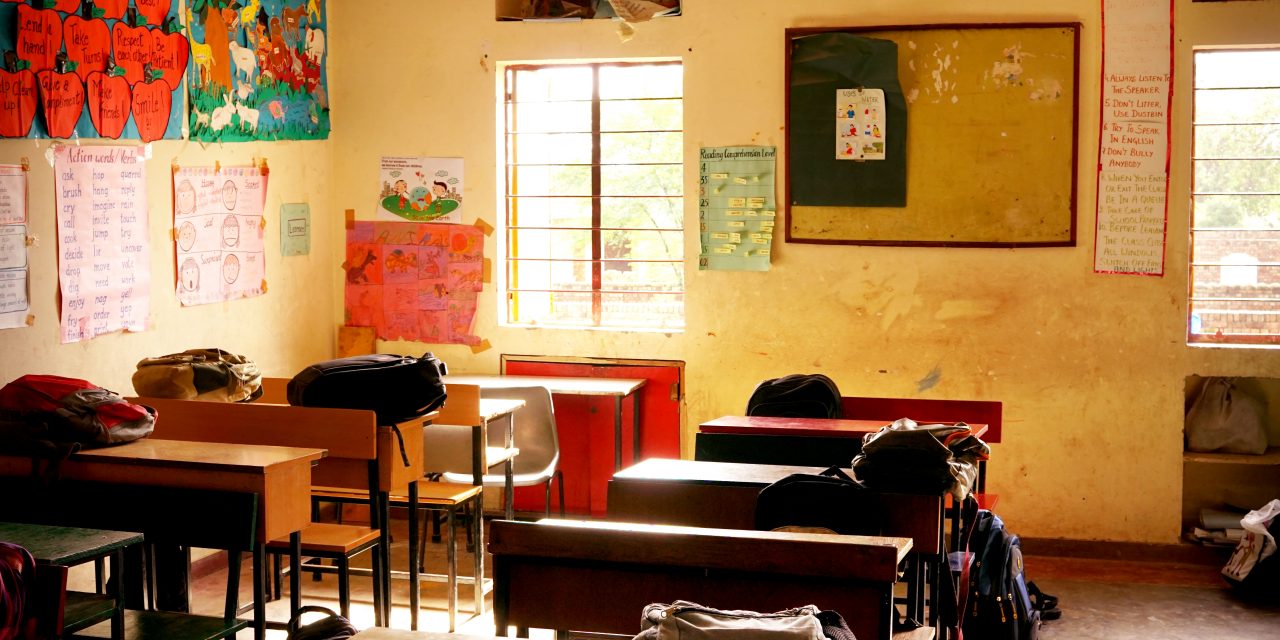Rubbish litters the streets of Chennai, India, where putrid smells and incessant honking of cars racing dangerously close to pedestrians underscore the city’s inability to handle a massive population. It is in this refuse that an elderly man sleeps, his head and shoulders protruding out into the road, and it is through these streets that Jake Green and Ben Guera walk back to their hotelwith the rest of their group. 
The young men stare at the elder in a small horror as they passed, his tattered and dirtied clothing blending in with the rubbishunderneath him, stirred only by cars speeding much too close. Not wanting to part with the group, Green and Guera keep walking. They awkwardly look to their friends, though none of them seem to have noticed. The men feel a weight tied to their feet, each step becoming more difficult than the last. Almost of their own accord, their feet spin around, and Green and Guera head back.
The man lay soundly sleeping, his head still precariously close to the cars whizzing past. Louder and louder, they call out to him, but he does not respond; even when they shake him, he does not stir. On the other side of the street, another man catches sight of their efforts and comes to their aid.
Unable to communicate with Green and Guera, he delivers the sleeping man a tight smack to the back, causing the young men to wince in sympathy for the elder, who finally opens his eyes, initially wide with surprise but now trained upon his assailant. The sleeping man bows in thanks, aware that the hit had been for his own good, before wandering off to find a safer spot to sleep.
“I realized that this might be the most kindness this man ever receives, and it comes in the form of a smack, in a blow,” Green said. “What a sad life that is. People are left to themselves, and no one gives a care, and, even if they do, it comes in pain.”
Green, an MBA student who graduated from The University of Alabama Honors College with a mechanical engineering degree, was one of a dozen STEM Path to the MBA students that went to India this summer. Green and the other students were looking for ways to improve the lives of Indians through reverse innovation, which caters to the vast population of the impoverished, selling them simple and inexpensive necessities such as water filters or inexpensive light bulbs, which generates a profit for producers and cheap solutions to everyday problems for consumers. Reverse Innovation, a term coined by Dr. Vijay Govindarajan, a professor at Dartmouth’s Tuck School of Business, is more sustainable than charity, since it is a form of business. Before the students could get to work designing products, however, they had to first immerse themselves in the Indian culture and find out what it means to be Indian.
From seeing train cars specifically marketed as “Air-Conditioned” to experiencing a 85-degree temperatures at 1 a.m., to finding caste-specified matrimonial ads in the newspapers, Green and Guera quickly realized that they were far from home.
“It’s awesome to see the number of different colors women would wear,” said Ruth Bishop, current MBA student and former UA Honors student, who graduated with biology and Spanish degrees.
Bishop actually got to don traditional Indian garb for part of the trip due to the modesty standards in place for women.
“It was fun to have an excuse to wear Indian clothes,” Bishop said. “So I didn’t really mind. I thought they were beautiful in their own way.”
The students would also go blazing down the streets at breakneck speeds, amid unre-lenting honking, ramming into each other as their driver swerved into oncoming traffic in order to pass a rickety vegetable truck. Sometimes the driver slammed on the breaks in the middle of the street in order to figure out directions, causing enraged Indians to fly around them, beeping their horns in protest.
“If you don’t honk, if you don’t have a horn, it’s almost like you’re driving with three wheels,” Green said. “You need that horn because it’s communicative. It tells where you are and what you’re going to do.”
Green and the rest of the students walk home from dinner through the Indian city streets, practically deserted save for the trash blowing in the wind.
Green caught a whiff of something and instantly scrunched his nose; although unpleasant smells are not uncommon in India, this was particularly pungent. Green tries not to think of the curry he just ate, instead focusing on the small, still frame and the larger one behind it standing in the middle of the sidewalk in front of them.
As they get closer, they make out that the figures are a child and a middle-aged policeman and begin to hear small cries coming from the child. The girl, barely even 2 years old, stares up at them. Green’s heart splintering, he realizes that the little girl is standing in her own diarrhea.
The group immediately starts questioning the policeman, but he will have nothing to do with them. Determined, Green sets out down the street and into a coffee shop, questioning anyone who will listen about the sick child.
Eventually, a woman walks in, hunched over, thin and her clothing dirtied and torn: a beggar. Green tries to explain to her that her child was sick, motioning towards the girl, who still stares wide-eyed at them both. However, the woman does not seem to care.
“We tried to tell her, ‘She’s very sick, I don’t know if you’ve seen,’” Green said. “But she just looked at us, and she said, ‘Baby makes money,’ and that’s all that she said.”
Extreme poverty is something many Indians face. Just in 2011, according to the World Bank, 21.2 percent of India’s population was below the poverty line, meaning 268 million Indians live on less than $1.90 every day.
In a migrant village on the outskirts of Delhi, a little girl leads Juan Carrasquilla, a mechanical engineering senior in UA’s Honors College, to her home to interview her family. Surrounded by used wrappers and containers, her house is about the size of a bedroom, with a small fan and a few lightbulbs, from which crude wiring spew, strung onto the tarp walls and sheet metal ceiling. A bed frame with twine braided end to end serves as the family’s bed, and a small jar containing a few gently folded bills sits beside it. The girl’s parents greet Carrasquilla, smiling and willing to share about their lives with him.
Carrasquilla can tell this family makes about 2,000 rupees a month, which is $1 per day. When Carrasquilla asks the girl’s parents what they would do if they had more money, they laugh, “How can we know if we do not have it?”
“The family joked a lot, and they laughed a lot, and they didn’t seem very unhappy about their situation,” Carrasquilla said. “That was very shocking to me, it really made me wonder why we value wealth so much, and I’m trying to picture myself in that situation, how would I respond?”
Fueled by their experiences, the STEM students were ready to start the intensive part of their trip. For the last week, the students met with villagers to discuss their needs and limitations, hoping to find ways to better the lives of the Indian people. The students divided into groups that each addressed certain problems such as the amount of trash on the streets, lack of proper lighting in houses, a failing education system and bacteria infested water.
Bishop and Carrasquilla worked to improve the Liter of Light model, which involves filling a plastic bottle with water and a tiny amount of bleach, which, when hung from a hole in the roof, refracts sunlight through the room, acting as a light bulb during the day. Bishop and Carrasquilla are presently figuring out how to store the sunlight gathered during the day in order to use it at night.
This light bulb, while a life-changing invention in India, could become a science project in the United States. Bishop and Carrasquilla are also working with Crimson Startup to market the bleach-bulb in the United States as a science project to supplement children’s education of recycling and renewable energy.
 School children crowd around Green, who questions them about their classes to further his research on education. His eye is drawn to a pale, lumpy scar on the arm of one of the girls. Green opens his mouth to ask her about it but closes it. The children’s principal, however, does not hesitate to question her about it.
School children crowd around Green, who questions them about their classes to further his research on education. His eye is drawn to a pale, lumpy scar on the arm of one of the girls. Green opens his mouth to ask her about it but closes it. The children’s principal, however, does not hesitate to question her about it.
“I had jaundice when I was a kid,” she replies, causing Green to raise an eyebrow. He could not understand the correlation. Later, once the children resumed their playing, the principal explains to Green that many conventional Indians treat jaundice by burning the child with either a metal rod or an assortment of herbs.
“It burns them,” Green said. “It doesn’t do anything good for the health, but it’s a tradition that they have, and it’s one of many examples that reflect how there is a lack of education of what truly works in health.”
Green, who worked on ways to further education in India, encountered some serious results stemming from a failing education system, where, according India’s Bureau of Planning, Monitoring and Statistics, only 69.3 percent of Indian adults were literate in 2011.
“When you go over, you would make assumptions that Indians are so well-educated because a lot of them are,” said Green, who is currently meeting with investors about his education project. “But there are also a lot of those who are more rural and don’t have the opportunity to, or maybe just don’t have the desire to pursue further education. So they are just sort of gridlocked in just a system that doesn’t work.”
While the students went to India with the mindset of enhancing the lives of Indians, they found that some Indian characteristics needed no improvements.
“The Indian people that we met were probably the nicest people I’d ever meet,” Green said. “People who were in such tight circumstances were just so welcoming of us and offered us so many things.”
Bishop agreed.
“Coming from a very materialistic culture to India, one of the most spiritual nations in terms of overarching cultural themes of being non-materialistic, was a positive experience,” Bishop said. “I wish we were like that in that way.”






